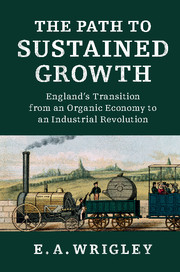 The Path to Sustained Growth
The Path to Sustained Growth Book contents
- Frontmatter
- Dedication
- Contents
- List of figures
- List of tables
- Acknowledgements
- Introduction
- 1 Organic economies
- 2 The classical economists
- 3 Energy consumption
- 4 Urban growth and agricultural productivity
- 5 Changing occupational structure and consumer demand
- 6 Demography and the economy
- 7 Transport
- 8 England in 1831
- 9 The completion of the industrial revolution
- 10 Review and reflection
- Bibliography
- Index
5 - Changing occupational structure and consumer demand
Published online by Cambridge University Press: 05 January 2016
- Frontmatter
- Dedication
- Contents
- List of figures
- List of tables
- Acknowledgements
- Introduction
- 1 Organic economies
- 2 The classical economists
- 3 Energy consumption
- 4 Urban growth and agricultural productivity
- 5 Changing occupational structure and consumer demand
- 6 Demography and the economy
- 7 Transport
- 8 England in 1831
- 9 The completion of the industrial revolution
- 10 Review and reflection
- Bibliography
- Index
Summary
The changing balance between primary, secondary, and tertiary employment in early modern England provides a valuable insight into the nature of the changes that were gradually transforming an organic economy into the first example of a completed industrial revolution. In organic economies it was normal for 70–80 per cent of the workforce to be employed on the land, reflecting the fact that labour productivity in agriculture was low. The secondary and tertiary sectors were always dwarfed by the primary sector. Ten peasants might produce enough food for their own families and perhaps two or three other families who were then able to engage in textile manufacture, handicrafts, building, retailing, transport, etc., but the surplus in question was limited and might prove fragile in hard times. For the same reason, the proportion of the population living in towns and cities was always modest. Labour productivity in agriculture was too low to support a large urban sector. Equally, the absence of a large urban demand for food meant that there was little incentive for a peasant farmer to increase his output since there was no guarantee that it would find a market.
Recently new estimates of the changing occupational structure of England in the early modern period have been made. They differ substantially from earlier estimates; they suggest that the rise in the proportion of the workforce in the secondary and tertiary sectors occurred earlier, and was larger than was once supposed. The revised estimates and their implications for the nature and timing of the changes that ultimately brought about an industrial revolution are the subject of this chapter. It should be noted that the estimates normally relate to the male labour force only.
The expansion of the secondary and tertiary sectors
Given the relative income elasticities of demand for the products of the primary, secondary, and tertiary sectors in organic economies, a very high proportion of the labour force engaged in agricultural production normally indicated a modest standard of living and sometimes deep poverty. The bulk of the population, if they engaged in market transactions, spent much of any income at their disposal to obtain food.
- Type
- Chapter
- Information
- The Path to Sustained GrowthEngland's Transition from an Organic Economy to an Industrial Revolution, pp. 67 - 100Publisher: Cambridge University PressPrint publication year: 2016
